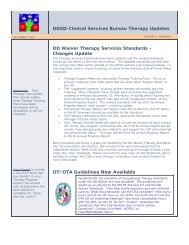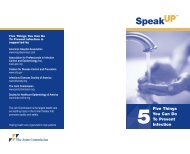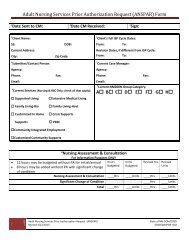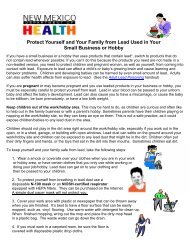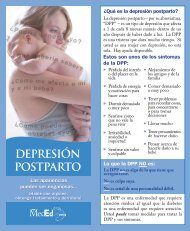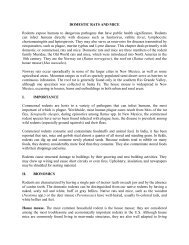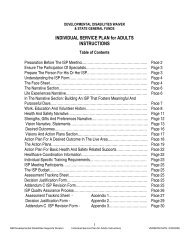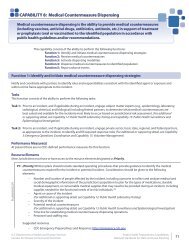Guidelines for the Identification and Management of Lead Exposure
Guidelines for the Identification and Management of Lead Exposure
Guidelines for the Identification and Management of Lead Exposure
Create successful ePaper yourself
Turn your PDF publications into a flip-book with our unique Google optimized e-Paper software.
CHAPTER 1.INTRODUCTION KEY POINTS• <strong>Lead</strong> exposure remains a public health problem <strong>for</strong> certain groups <strong>of</strong> women <strong>of</strong> childbearing age <strong>and</strong> <strong>for</strong> <strong>the</strong> developing fetus <strong>and</strong> nursing infant. Prenatal lead exposure has knowninfluences on maternal health <strong>and</strong> infant birth <strong>and</strong> neurodevelopmental outcomes.• Bone lead stores are mobilized in pregnancy <strong>and</strong> lactation <strong>for</strong> women with prior leadexposure, which is a concern since lead released into maternal blood <strong>and</strong> breast milk canadversely affect <strong>the</strong> fetus or newborn.• Certain population subgroups <strong>of</strong> women at increased risk <strong>for</strong> exposure have been identified <strong>and</strong> may be highly exposed, particularly <strong>the</strong> following: workers in certain occupations;<strong>for</strong>eign-born recent immigrants; <strong>and</strong> those practicing certain behaviors associated withlead exposure, such as pica or renovation <strong>of</strong> older homes.• Identifying pregnant women with a history <strong>of</strong> lead poisoning or who are currently exposedto lead above background levels <strong>and</strong> preventing additional lead exposure can help preventadverse health outcomes in <strong>the</strong>se children.Despite improvements in environmental policies <strong>and</strong> significant reductions in U.S. average population bloodlead levels, lead exposure remains a concern <strong>for</strong> pregnant <strong>and</strong> lactating women among certain populationsubgroups at increased risk <strong>for</strong> exposure. There is increasing awareness that unintended exposures to environmentalcontaminants, such as lead, adversely affect maternal <strong>and</strong> infant health, including <strong>the</strong> ability to becomepregnant, maintain a healthy pregnancy, <strong>and</strong> have a healthy baby. In <strong>the</strong> United States, women <strong>of</strong> childbearingage represent approximately 42% <strong>of</strong> <strong>the</strong> total population (American Community Survey 2004) <strong>and</strong> atany given time almost 9% are pregnant (Crocetti et al. 1990). In <strong>the</strong> 2003-2006 National Health <strong>and</strong> NutritionExamination Survey (NHANES) survey, <strong>the</strong> 95th percentile <strong>for</strong> blood lead levels among women aged 15-49 was2.4 micrograms per deciliter (µg/dL). As Figure 1-1 indicates, blood lead levels among women aged 15-49 havedropped substantially since <strong>the</strong> 1976-1980 NHANES. Recent NHANES estimates suggest that almost 1% <strong>of</strong>women <strong>of</strong> childbearing age (15-49 years) have blood lead levels greater than or equal to 5 µg/dL (Centers <strong>for</strong>Disease Control <strong>and</strong> Prevention 2008, unpublished data).<strong>Lead</strong> exposure remains a public health problem <strong>for</strong> subpopulations <strong>of</strong> women <strong>of</strong> childbearing age <strong>and</strong> <strong>for</strong> <strong>the</strong>developing fetus <strong>and</strong> nursing infant <strong>for</strong> several important reasons. First, prenatal lead exposure has knowninfluences on maternal health <strong>and</strong> infant birth <strong>and</strong> neurodevelopmental outcomes (Bellinger 2005). Researchfindings suggest that prenatal lead exposure can adversely affect maternal <strong>and</strong> child health across a widerange <strong>of</strong> maternal exposure levels. In addition, adverse effects <strong>of</strong> lead are being identified at lower levels <strong>of</strong> exposurethan previously recognized in both child <strong>and</strong> adult populations (Canfield et al. 2003; Jusko et al. 2008;Lanphear et al. 2005; Menke et al. 2006; Navas-Acien et al. 2007; Tellez-Rojo et al. 2006).Second, bone lead stores are mobilized during periods <strong>of</strong> increased bone turnover such as pregnancy <strong>and</strong> lactation.Over 90% <strong>of</strong> lead in <strong>the</strong> adult human body is stored in bone (Barry 1975; Barry <strong>and</strong> Mossman 1970), <strong>and</strong>may result in redistribution <strong>of</strong> cumulative lead stores from bone into blood during periods <strong>of</strong> heightened boneturnover, such as pregnancy <strong>and</strong> lactation (Gulson et al. 2003; Roberts <strong>and</strong> Silbergeld 1995). Since bone leadstores persist <strong>for</strong> decades, women <strong>and</strong> <strong>the</strong>ir infants may be at risk <strong>for</strong> continued exposure long after exposureto external environmental sources has been terminated.1




